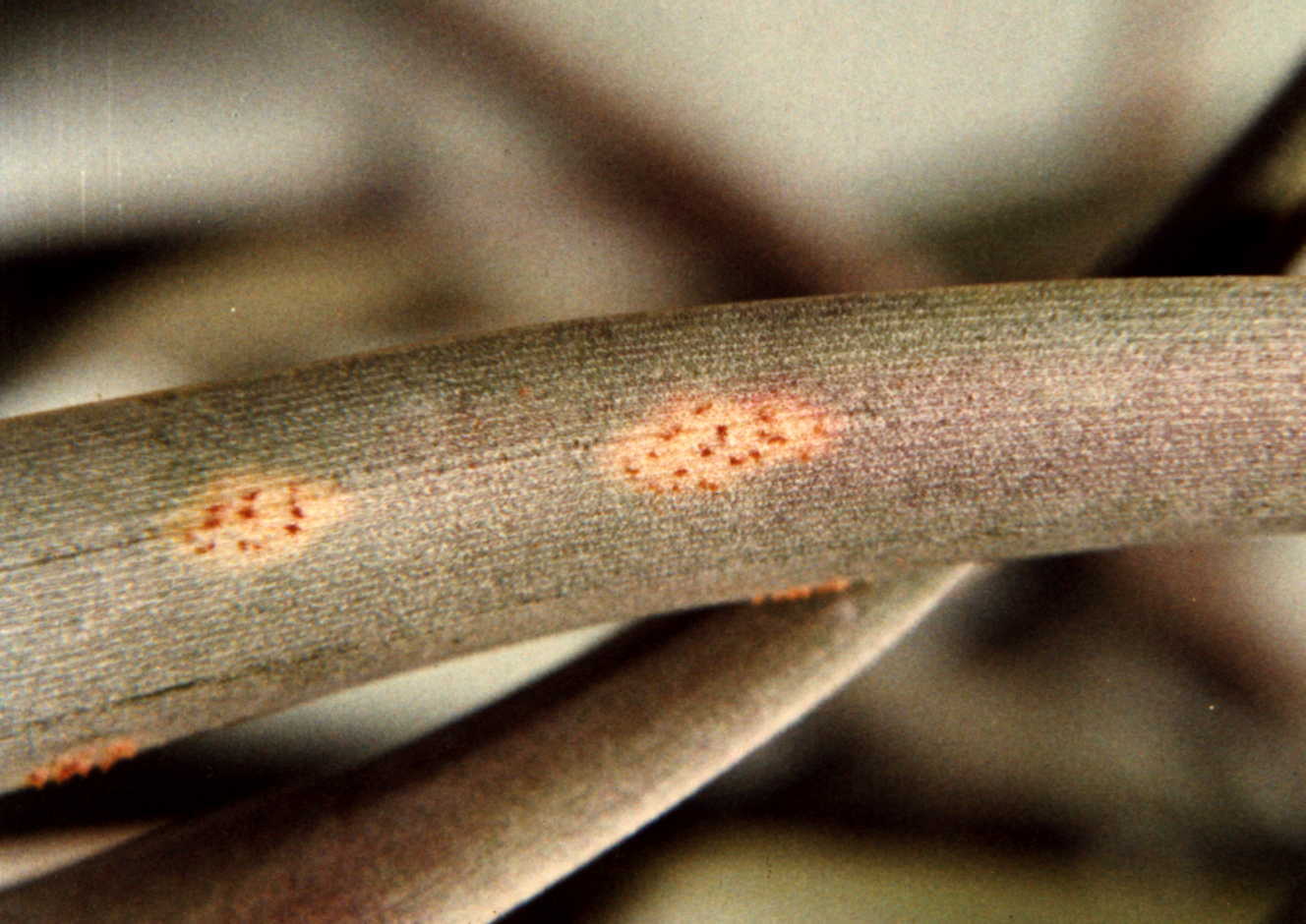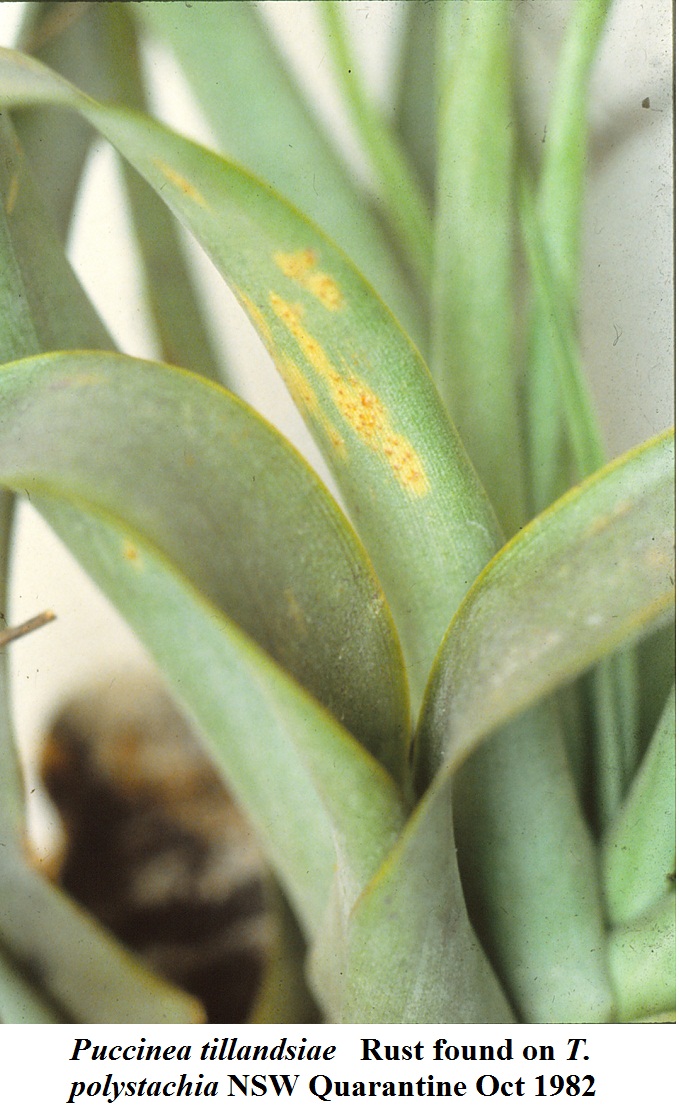

Tillandsia rust (Puccinea tillandsiae) was first reported in Bromeletter Nov/Dec 1982. Since then it has slipped through quarantine and is now showing up in Australian collections.
Rust is a fungi that grows on the underside of the leaf. The pustules, when fully grown, release spore and are carried by the wind. They can carry for hundreds of kilometres to affect other tillandsias. The underside of an infected leaf will look similar to the underside of an elkhorn leaf (Platycerium bifurcatum) when it is setting spore, a brownish, furry mass.
Unfortunately, the spores from this rust may lay dormant for years undetected. Plats must be watched closely and I recommend all plants coming into your collection to be dipped to prevent rust. If rust is found, remove infected leaves and dip or saturate spray ALL plants. This should be repeated at seven day intervals, using either Dithane M45 or Tilt.
Information about this rust is still patchy. We don’t know if it confines itself to tillandsias or can spread to other genera of bromeliads.
(Name withheld at the writer’s request.)
RUSTS ON BROMELIADS
A BSA member, concerned over the rust Puccinia tillandsiae being discovered on imported tillandsias, wrote to the Editor of the U.S. Bromeliad Society Inc. journal, Mr. Tom Lineham, asking for information on what was being done for the problem in the U.S.
Mr Lineham was very prompt in collecting information on the following questions asked of him:
• Is tillandsia rust common in North American collections ?
• Is the rust confined to tillandsias, or what other bromeliads are susceptible ?
• Is the rust common in green or grey tillandsias ?
• Which tillandsias are most susceptible to rust ?
• What chemicals are most suitable to control rust ?
Mr Harry Luther sent Mr Lineham information from the Florida Department of Agriculture and Consumer Services. This described nematode species recovered from soil about the roots of bromeliads shipped from Guatemala to California. Mr Lineham contacted the author of the paper, Dr. Paul S. Lehman, for information about tillandsia rust. He generously supplied details summarized as follows:
1. Four rusts have been reported in bromeliads:
- Puccinia tillandsiae (1960), on Tillandsia punctulata, Costa Rica
- Puccinia pitcairniae (1890), on Pitcairnia pungens, Ecuador
- Puccinia pitcairniae spp. chapalensis (1899) on Pitcairnia palmeri, Chapala, Jalisco, Mexico
- Uredo nidularii (1898), on Nidularium longiflorum, Ule, Serra dos Orgaos, Brazil
2. Puccinia tillandsiae has been found on tillandsia species from Guatemala, Honduras, Jamaica, Mexico, Nicaragua, and Panama.
This disease was found on native Florida T. fasciculata at seven locations between November 1980 and July 1981. These are the only records available from the Florida Department of Agriculture as this is written.
A large volume tillandsia importer in California said he is only aware of two cases of unspecified rust infestation in the past four years, and that T. tricolor and T. seleriana were affected.
3. The symptoms vary of course. Puccinia tillandsiae, for example, often forms non-erumpent (blister-like) spots on the tillandsia leaves. These are readily observed against a bright background such as a bright day.
4. The final question about what chemicals are the most suitable to control rust does not have an easy answer, as chemical controls are strictly regulated, and assistance from agricultural authorities should be obtained.
Mr. Lineham also contacted Dr. Arthur W. Engelhard, who described an experiment with rust-infected geraniums, which came about because a grower had his crop infected by a shipment of diseased cuttings.
They were not permitted to move the plants to the research centre so they began to experiment with various chemical sprays in the owner’s greenhouse with infected and healthy plants ranged on the benches.
After they ran out of space in the big glasshouse, they moved to a small glasshouse where they installed more diseased and healthy plants. The humidity in that house was relatively low and the heat exceeded 950F. They soon observed that the disease did not spread to the healthy plants, and neither did the disease progress in the infected plants. They concluded that the heat destroyed the airborne spores of the disease. (Successful treatment of geranium rust, which has its origins in temperate regions, is not proof that heat treatment could be effective with rust affecting plant from tropical areas, but if chemicals are not permitted, the grower may be faced with the choice of destroying infected plants or of experimenting with heat treatment.) Dr. Engelhard suggested that growers with small collections might have more success with heat treatment because they can better control the temperature and humidity in small greenhouses. He said they might also use polyethylene bags as miniature greenhouses but to use great care to avoid cooking the plants.
References
1. Nematology Circular No. 129, May 1986. Division of Plant Industry
2. Mycolooia 66:533-536, 1974
3. McRichie, J.J., Burnett, H.DC. A Rust on Tillandsia New to the United States. Plant Pathology Circular No. 244, May 1981 (2p). Florida Department of Agriculture and Consumer Services, Division of Plant Industry.
4. Dr. Paul S. Lehman, Plant Pathologist, Gulf Coast Research and Education Center, Apopka, an agency of the University of Florida.
5. Dr. Arthur W. Engelhard, Plant Pathologist, Gulf Coast Research and Education Center, Bradenton, FL, also an agency of the University of Florida.
We would all be grateful to learn more from readers about their experiences with these diseases and effective controls. It would also be of benefit to know which tillandsias have proved susceptible to tillandsia rust in our collections.
O.F. (Olwen Ferris), Editor